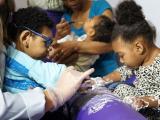Researchers monitoring pregnant monkeys experimentally infected with Zika virus have found new clues about brain damage in babies, even in those normal head sizes, and certain areas of the brain that could be vulnerable, even in early childhood or adolescence.
In other Zika developments, another group of researchers who studied Brazilian twins born to infected mothers found clues of a possible genetic susceptibility to the impact of the virus on the brain.
MRI shows subtle problems, specific areas
In the first study, investigators looked for subtle changes in the brains of five macaque fetuses of mothers who had been infected with Zika virus. A team based at the University of Washington (UW) School of Medicine reported its findings today in the latest edition of Nature Medicine. They noted that macaques are one of the closest animal models for studying human pregnancy.
Weekly monitoring with ultrasound found obvious abnormality in only one of the five fetuses. Though their brains grew more slowly than normal, they didn't meet the US Centers for Disease Control and Prevention microcephaly criteria.
However, when the group did magnetic resonance imaging (MRI) scans of the fetal brains, they found that four of the five were abnormal. The scans revealed that certain areas weren't growing as quickly as others. Some of the hard-hit areas were those that generate new brain cells, such as the subventricular zone in the lateral ventricle wall—an area that contains the most neural stem cells.
Another injury area that stood out in the MRI analysis was the subgranular zone of the dentate gyrus in the hippocampus, where neural stem cells are involved in memory and learning and contribute to brain health through at least adolescence.
Concerns about infections in kids
Lakshmi Rajagopal, PhD, study coauthor and associate professor of pediatrics and a newborn infectious disease expert at UW School of Medicine, said in a UW press release that because vulnerable neural stem cells in the hippocampus are present during childhood and adolescents, a worry is that virus infection in children and young adults may significantly affect brain health.
"Subtle damage caused by this virus during fetal development or childhood may not be apparent for years, but may cause neurocognitive delays in learning and increase the risk of developing neurological disorders such as schizophrenia and early dementia," she said. "These findings further emphasize the urgency for an effective vaccine to prevent Zika virus infections."
Kristina Adams Waldorf, MD, study coauthor and professor of obstetrics and gynecology at UW School of Medicine who specializes in maternal and fetal infections, said in the release that current head-size criteria for diagnosing Zika virus may not flag more subtle brain damage that can lead to learning and mental health problems later in life. "We are diagnosing only the tip of the iceberg."
All children exposed to Zika virus before birth should be followed for long-term problems, regardless of head size, the authors say.
Clues to genetic susceptibility
In the other study, Brazilian researchers have found early evidence that genetics may play a role in susceptibility to Zika-related birth defects. A team from the University of Sao Paulo's Human Genome and Stem Cell Research Center reported its findings Feb 2 in Nature Communications.
The investigators note that from 6% to 12% of babies born to mothers infected with Zika virus will have Zika-related birth defects, raising questions about whether some babies may have a genetic predisposition.
To help sort out environmental and genetic factors, they set out to study both identical (monozygotic) and nonidentical (dizygotic) twins. Starting in 2016, the team looked for twins in which at least one baby had microcephaly, finding nine pairs of twins from six of Brazil's states.
Of the group, two pairs were identical twins, both of which had Zika-linked birth defects. Of seven nonidentical pairs, one pair was both affected, but of the other six pairs, only one twin had birth defects. A "discordant" condition is one that affects one dizygotic twin and not the other.
The researchers obtained blood samples from three pairs of the discordant dizygotic twins, then used the samples to generate human-induced pluripotent stem cells, which were transformed into neural progenitor cells (NPCs), which form the brain and other parts of the central nervous system.
In the next phase of the study, the team infected the NPCs with a Brazilian Zika virus strain. After 4 days, plaques from cells of affected babies had significiantly less cells than plaques grown from cells of the nonaffected babies.
Experiments with neurospheres, cells grown in 3D structures, showed similar growth impairment from affected twins' cells. The researchers, however, saw no difference when they compared noninfected cultures from the cells of affected and nonaffected babies. Examination using fluorescence found more Zika virus in cells from affected babies compared with healthy ones.
Other experiments suggested the NPCs of babies born with Zika effects produces significantly more viral RNA copies and more viruses capable of infection, suggesting that the NPCs were more infected and did not proliferate as much as those from the protected twins.
Lab cells mimicked twin patterns
Mayana Zatz, PhD, one of the study authors, said in a press release from the University of Sao Paulo, that in the lab the cells mimicked what happened with the babies, with results the same for all three pairs of twins. "We demonstrated that the infection is not random. It reinforces our hypothesis of a genetic component increasing the susceptibility to congenital Zika syndrome."
To identify a possible genetic component, they looked at gene sequences from eight pairs of twins and 10 other babies that had Zika-related birth defects. The analysis didn't turn up a single gene variation that pointed to infection susceptibility, which they said excluded that possibility.
RNA sequencing to investigate gene expression, however, pointed to a group of genes that have the capacity to distinguish susceptible cells from more resistant ones. The largest alteration they found was related to a protein involved in the inhibition of mTor signaling, a pathway involved in cell grown and death that had been linked to previous studies that found an association between the mTor pathway and Zika virus replication.
In samples from affected babies, RNA sequencing also found lower expression of two other genes that play a role in cerebral development during fetal growth.
See also:
Feb 5 Nat Med abstract
Feb 5 UW press release
Feb 2 Nat Commun abstract
Feb 2 University of Sao Paulo press release





















